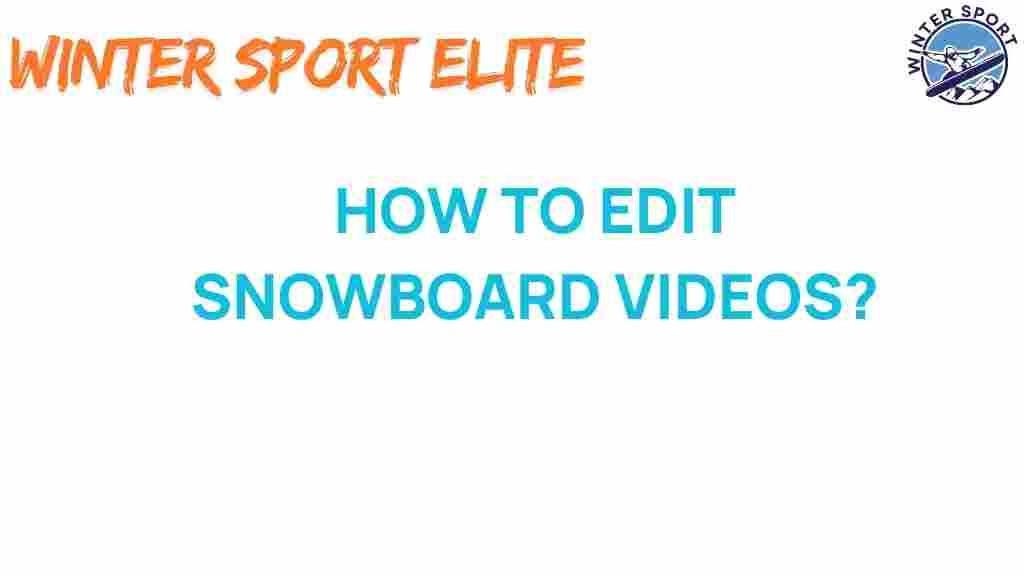Mastering the Art of Snowboard Video Editing: Tips and Tricks
Snowboarding is not just a thrilling sport; it’s an incredible source of inspiration for creativity and storytelling. With the rise of social media and video-sharing platforms, snowboard video editing has become essential for enthusiasts looking to share their passion. In this article, we will explore effective tips, tricks, and techniques for editing snowboard videos that captivate audiences and showcase your skills.
Understanding the Basics of Filming
The foundation of great snowboard video editing starts with effective filming. Here are some crucial tips for capturing stunning footage:
- Choose the Right Equipment: Invest in a good camera capable of shooting in high resolution. GoPro cameras are popular among snowboarders for their portability and durability.
- Use Proper Angles: Experiment with different angles when filming. Low angles can create a dramatic effect, while aerial shots can showcase the landscape.
- Lighting Conditions: Snowboarding is often done in bright sunlight or cloudy conditions. Ensure you understand how lighting affects your footage. Early morning or late afternoon light (golden hour) can add a beautiful touch to your videos.
- Stabilization: Use a gimbal or a camera with built-in stabilization to avoid shaky footage, which can detract from the viewing experience.
Creative Storytelling in Snowboard Videos
Every snowboard video should tell a story. Whether it’s a day on the slopes with friends or a personal journey in the sport, storytelling enhances viewer engagement. Here are some techniques to consider:
- Define Your Narrative: What message do you want to convey? Is it about the thrill of snowboarding or the camaraderie of friends? Having a clear narrative will guide your editing process.
- Incorporate a Theme: Use themes such as adventure, freedom, or overcoming challenges. This will help create a cohesive video.
- Include Interviews or Voiceovers: Personal anecdotes or insights can add depth to your story. Consider recording voiceovers during the editing phase.
- Use Music to Set the Tone: The right soundtrack can elevate your video. Choose music that matches the mood and pacing of your footage.
Post-Production Techniques
Once you have your footage, it’s time for the fun part: editing! Here’s a step-by-step guide to the post-production process:
1. Organize Your Footage
Before diving into editing, organize your clips. Create folders for different categories (e.g., tricks, scenic shots, interviews) to streamline your workflow.
2. Choose Your Editing Software
There are various video editing software options available, ranging from beginner-friendly tools like iMovie and Filmora to professional-grade software like Adobe Premiere Pro and Final Cut Pro. Choose one that fits your skill level and editing requirements.
3. Create a Rough Cut
Start by laying out your clips in chronological order or according to your narrative. Don’t worry about perfection at this stage; focus on getting the structure right.
4. Refine Your Edits
Once your rough cut is in place, begin refining your edits. Cut out unnecessary footage, adjust the timing of your clips, and ensure smooth transitions between scenes.
5. Add Effects and Transitions
Utilize effects and transitions to enhance your video. Simple cuts and fades can maintain a professional look, while creative transitions can add flair.
6. Color Grading
Color grading is crucial in snowboard video editing. Adjust the brightness, contrast, and saturation to make your footage pop and maintain a consistent look throughout the video.
7. Incorporate Audio
Layer in your chosen music track, and adjust the volume levels to ensure clarity. If you included voiceovers, sync them with your visuals carefully.
8. Final Review
Watch your video multiple times, checking for any inconsistencies or areas that need improvement. Ask for feedback from friends or fellow snowboarders to gain new perspectives.
Troubleshooting Common Issues
Even experienced editors encounter challenges. Here are some common problems and solutions:
- Shaky Footage: If you didn’t use stabilization equipment, consider using software stabilization features available in most editing programs.
- Audio Sync Issues: If your audio is out of sync, use the timeline to adjust the audio track until it matches the video.
- Color Mismatches: If your clips have varying colors, use the color grading tools to match them for a cohesive look.
- Too Long Videos: If your video is longer than intended, consider cutting out less impactful scenes. Remember, shorter videos often engage viewers better.
Enhancing Creativity in Your Edits
Creativity is the heart of snowboard video editing. Here are some tips to enhance your creative process:
- Experiment with Styles: Try different editing styles, such as slow motion for dramatic tricks or fast cuts for energetic moments.
- Incorporate Animation: Use graphics and animated text to highlight important points or add flair to your video.
- Collaborate with Other Creators: Working with other snowboarders or videographers can provide fresh ideas and perspectives.
- Stay Inspired: Watch other snowboard videos, not just for technique but for inspiration. Platforms like YouTube and Vimeo have vast collections of snowboard content.
Conclusion
Mastering snowboard video editing involves a combination of technical skills, creative storytelling, and a passion for the sport. By following the tips, tricks, and techniques outlined in this article, you’ll be well on your way to producing captivating snowboard videos that resonate with audiences. Remember to keep experimenting and pushing your creative boundaries.
For more insights on video editing, you can explore this resource. And to see some inspiring snowboard footage, check out this video. Happy editing!
This article is in the category Gear and created by WinterSportElite Team
